Call of the wild
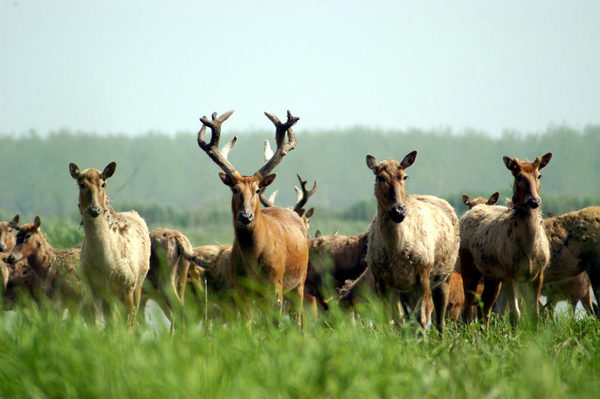
Once extinct on its Chinese native soil, and with only 18 individuals remaining in the world, the milu, also known as Pere David's deer, has witnessed a remarkable revival after efforts to reintroduce the species began a few decades ago. GUO GENG/FOR CHINA DAILY
With its miraculous twists and turns, the fate of the China's milu deer has long been an intriguing prospect for researchers and animal lovers alike.
Once extinct on its native soil and with only 18 individuals remaining in the world, the milu-which is also known as Pere David's deer in the West-has witnessed a remarkable revival after efforts to reintroduce the species began a few decades ago.
The International Union for Conservation of Nature believes the reintroduction program of the milu is one of the 15 most successful programs out of 138 similar projects carried out worldwide.
A Chinese totem
The milu, which is often referred to in China by its ancient name, the "four dislikes", because of its body features which resemble a combination of four other animals (the cow, deer, camel and horse), is a species of deer that's recognizable by its unique, rear-facing antlers.
The species is often depicted as a mount in mythology and was believed to be a sign of auspiciousness and symbol for imperial power in ancient China.
"The milu has a long history and has always played an important role in traditional Chinese culture," says Guo Geng, curator of the Nanhaizi Milu Park Museum in Beijing.
The milu was mentioned in early inscriptions on ancient oracle bones, and records about their habitat, distribution, behavior, hunting and uses have appeared in more than 100 historical works since the Han Dynasty (202 BC-AD 220), according to Guo.
While more than a million milu roamed China's wetlands 3,000 years ago, their numbers fell dramatically due to overhunting and the shrinking of nature habitats as the human population grew, especially after the Ming Dynasty (1368-1644).
A herd of about 200 milu-believed to be the last one in the world at that time-was kept at the Nanhaizi Imperial Hunting Lodge near Beijing in the 19th century.
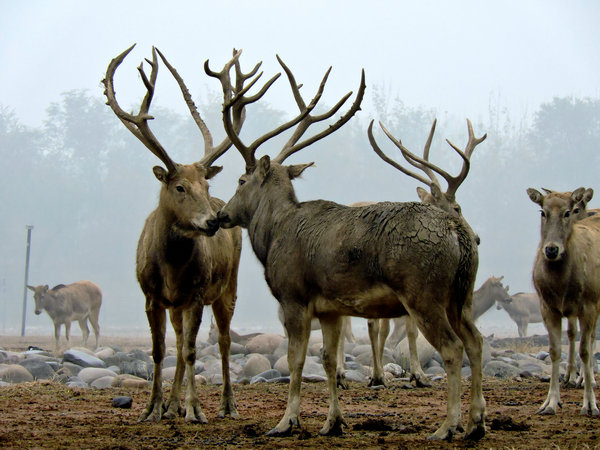
Once extinct on its Chinese native soil, and with only 18 individuals remaining in the world, the milu, also known as Pere David's deer, has witnessed a remarkable revival after efforts to reintroduce the species began a few decades ago. GUO GENG/FOR CHINA DAILY
Surviving in foreign lands
In 1865, the French missionary and naturalist Father Armand David found the captive animals at the lodge and managed to take some specimens to Europe to exhibit. They were identified as a new species and named after David.
When a flood damaged the wall of the hunting lodge toward the end of the 19th century, 120 of the milu escaped, most were hunted down by famished locals, leaving less than 30 at the lodge.
After the Nanhaizi hunting lodge was looted during the Eight-power Allied Forces invasion of 1900, the deer were never seen again in China.
However, many of the milu that were shipped to Europe and kept in city zoos continued to thrive.
Those who imported the deer for their own amusement had little inkling that they would become something of a Noah's Ark for the species.
In 1898, England's 11th Duke of Bedford who was fond of deer, started rounding up the rest of the world's milu population-some 18 in total-and bred them at his property, Woburn Abbey.
The group became the ancestors of all the milu in the world today.
The number of milu in the abbey had reached 255 when World War II broke out.
Before the war, the owner of abbey was proud to have "the only milu herd in the world" and refused to give away individual animals.
However, the son of the 11th Duke of Bedford feared that this remaining group of deer would once again be destroyed by war, and finally decided to transfer them to major zoos, both in England and abroad.
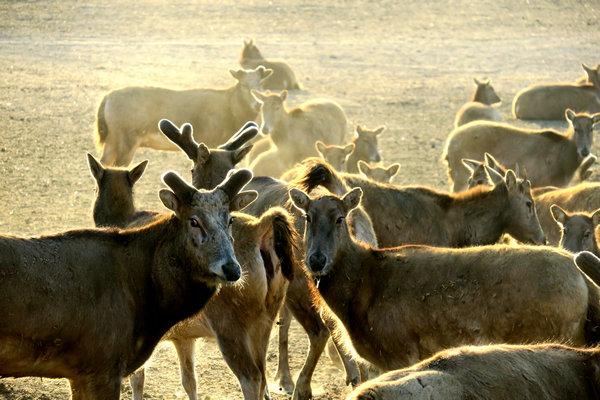
Once extinct on its Chinese native soil, and with only 18 individuals remaining in the world, the milu, also known as Pere David's deer, has witnessed a remarkable revival after efforts to reintroduce the species began a few decades ago. GUO GENG/FOR CHINA DAILY
Returning home
In 1985, 22 deer were sent from Britain as an international goodwill gesture to Beijing's Nanhaizi Milu Park.
"Nanhaizi was the place where milu were discovered and scientifically identified, and where they last lived in China 100 years ago," says Guo.
"It has been a very accurate reintroduction site, and the project also brings a happy ending to the species' intriguing story."
According to Guo, there are several advantages about making Nanhaizi as the site of reintroduction for the milu.
It has a relatively large area and is a suitable environment in a big city like Beijing, where top-level researchers are available from a range of organizations, Guo says.
Both Beijing and Daxing district governments have attached great importance to the protection of the deer since then. Milu Park and Beijing Milu
Ecological Research Center were also founded in the Nanhaizi area.
A total of 160 million yuan has been invested in relevant conservation work, mainly including recovering wetland systems in Milu Park, boosting research and technology, and establishing ex-situ conservation programs with the Beijing Academy of Science and Technology, which operates the research center.
Over the years, the park has successfully overcome challenges in breeding conservation, feeding management and disease control, and the deer population has grown steadily.
The number of milu living in the park sits at around 170, which suits its environmental capacity. But more than 500 milu have been exported, which has helped to establish 38 remote conservation bases-accounting for over 70 percent of all the milu protection sites in China, according to Guo.
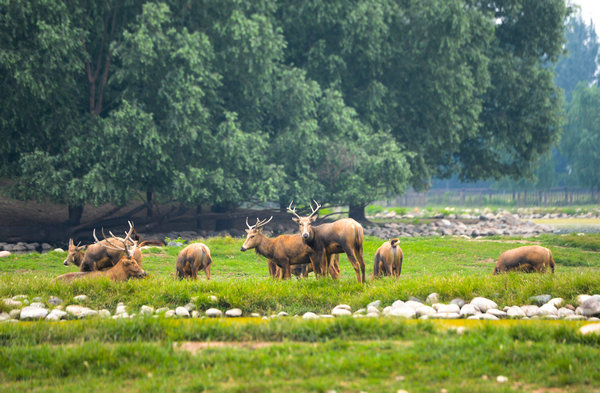
Once extinct on its Chinese native soil, and with only 18 individuals remaining in the world, the milu, also known as Pere David's deer, has witnessed a remarkable revival after efforts to reintroduce the species began a few decades ago. GUO GENG/FOR CHINA DAILY
Back to the wild
In 1998, some of the deer escaped from the Shishou Milu Nature Reserve in Hubei province during a flood. They spread along the Yangtze River and eventually formed purely natural populations in areas including eastern Dongting Lake, where about 150 individual wild milu live.
"Since then, wild populations of milu have reappeared in China after many centuries," says Bai Jiade, director of the Beijing Milu Ecological Research Center.
According to Bai, the entire milu population in China has grown to more than 6,000, and the species has basically been saved from extinction.
His center has worked with many other milu bases over the years on projects aimed at introducing more milu into wild environments.
For example, nearly 50 milu were released into the wetland area surrounding Poyang Lake in Jiangxi province in 2017. It was the first time that milu have been released into the wild at the largest freshwater lake in China.
Before the release, researchers conducted a five-year experiment on the suitability of the area as habitat, and conducted scientific investigations to confirm whether the wetland ecological environment was suitable for the breeding and growth of the milu population.
Each animal is implanted with an identification chip, several of which are attached to a GPS collar that relays location data in order to facilitate the monitoring of its survival.
According to the Wildlife Protection Administration of Jiangxi province, they plan to release more milu annually in the Poyang Lake area over the next five to 10 years, in order to gradually establish a wild population and enrich the biodiversity of the lake.
In Jiangsu's Dafeng Milu Nature Reserve, which is home to the world's largest single milu population, efforts to reintroduce the species into the wild have spanned the past two decades.

Guo Geng (right), the curator of the Nanhaizi Milu Park Museum, who has worked as a protector of the milu for 20 years, says he is happy to be called a spokesman for the animal. GUO GENG/FOR CHINA DAILY
Genetic concern
According to Bai, with bigger conservation efforts, overhunting is no longer a threat, but other factors have become the focus for the protection of the milu as a critically endangered species.
Inbreeding has led to a number of reproductive problems, including low birthrates, which have led to frequent abnormal and difficult births, diseases, and an imbalanced sex ratio.
"It happens to many endangered species. It will take a long time for the milu to regain its genetic diversity," Bai says.
Since 2017, Bai's center has started a research program to collect data on the health conditions of both the milu and their habitat.
During the initial stages of their research, the center collected relevant data from six milu bases around China. Information on the deer population, inheritance, faeces, hormones and parasites were closely monitored using a painless sampling technique developed for wild animals.
"The goal is to establish a health database for the milu and a system to evaluate their habitat, so we have standard reference points if any abnormality occurs in the future."
Bai says cases in which a large number of milu deaths are reported due to disease outbreaks in recent years have proven that this kind of monitoring is meaningful for the milu, as a reintroduced species developed from a small founding population.
"By strengthening our monitoring processes, we will not only learn about the situation of their genetic diversity, emerging trends and evolutionary potential, but also formulate counter measures for major threats to reduce the risks of extinction, and lay a foundation for the long-term survival of the species," Bai says.
Cross-breeding projects are also carried out internationally.
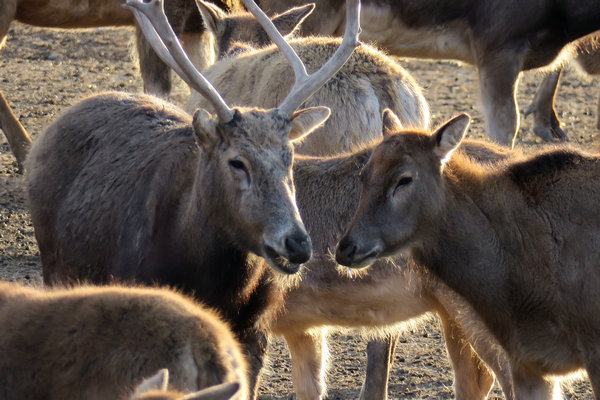
Once extinct on its Chinese native soil, and with only 18 individuals remaining in the world, the milu, also known as Pere David's deer, has witnessed a remarkable revival after efforts to reintroduce the species began a few decades ago. GUO GENG/FOR CHINA DAILY
In 2017, the World Wide Fund for Nature signed a memorandum of understanding with the Forestry Bureau of Hunan province to promote a program of crossbreeding for the milu jointly between Europe and China.
Under the plan revealed by the WWF, milu from Woburn Abbey Deer Park in Britain will travel to China to help breed younger generations by avoiding the degeneration of the gene pool.
The Beijing Nanhaizi Milu Culture Conference was recently held to celebrate the 33rd anniversary of the return of milu to China as a biological group.
The event was jointly organized by the Administration Department of Wildlife Protection and the Natural Reserve under the State Administration of Forestry and Grassland, Beijing's Daxing district government and the Beijing Academy of Science and Technology-in conjunction with two other organizations-at Nanhaizi Milu Park.
During the conference, both the local government and scientists eagerly expressed their hope of making milu one of the mascots for the 2022 Beijing Winter Olympics and listing it as a World Natural Heritage to further promote the endangered species.
According to Dominique Bauquis, a special representative who spoke at the conference on behalf of the Woburn Abbey Deer Park, these efforts to underline the importance of the milu can only help to raise the profile of this extraordinary species.
"Should the milu become one of the 24th Winter Olympics' mascots, it would place natural conservation at the forefront of the Games and give China a positive image in this field, as the tale of the milu epitomizes the outstanding human achievements in biodiversity conservation, and shows what international collaboration can achieve," Bauquis says.
"It has never been more relevant as a positive and incredible success story at a time when biodiversity is under threat worldwid.”

